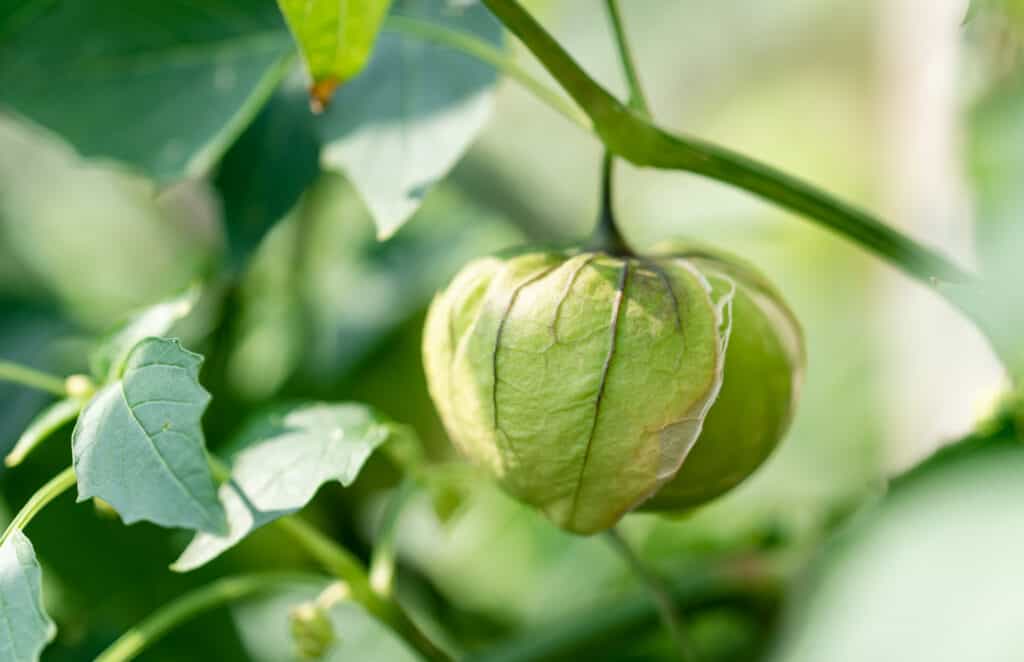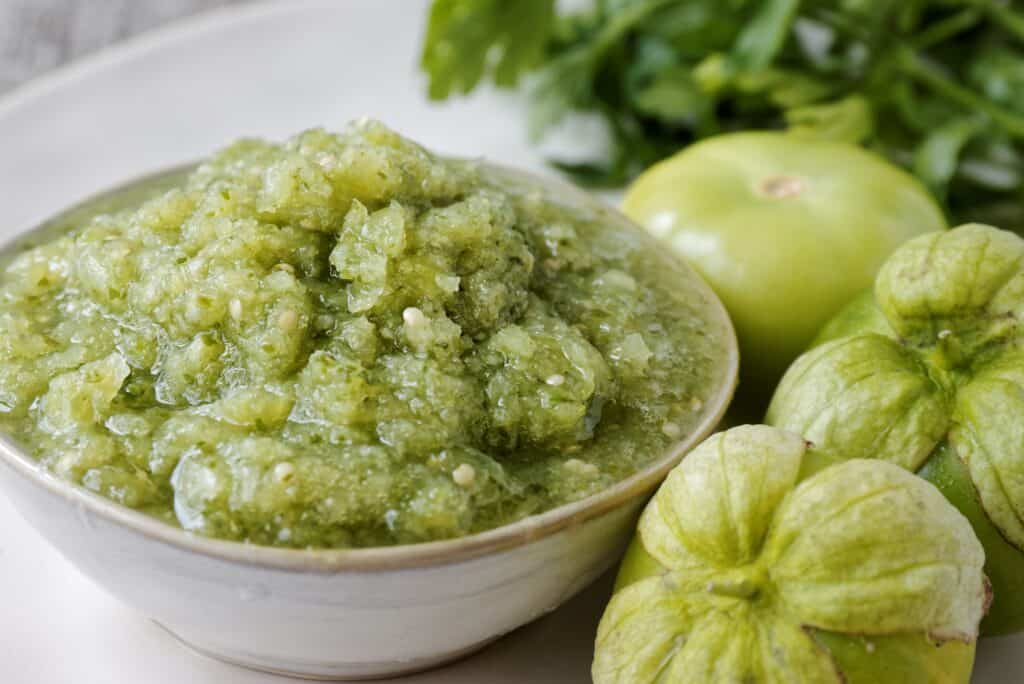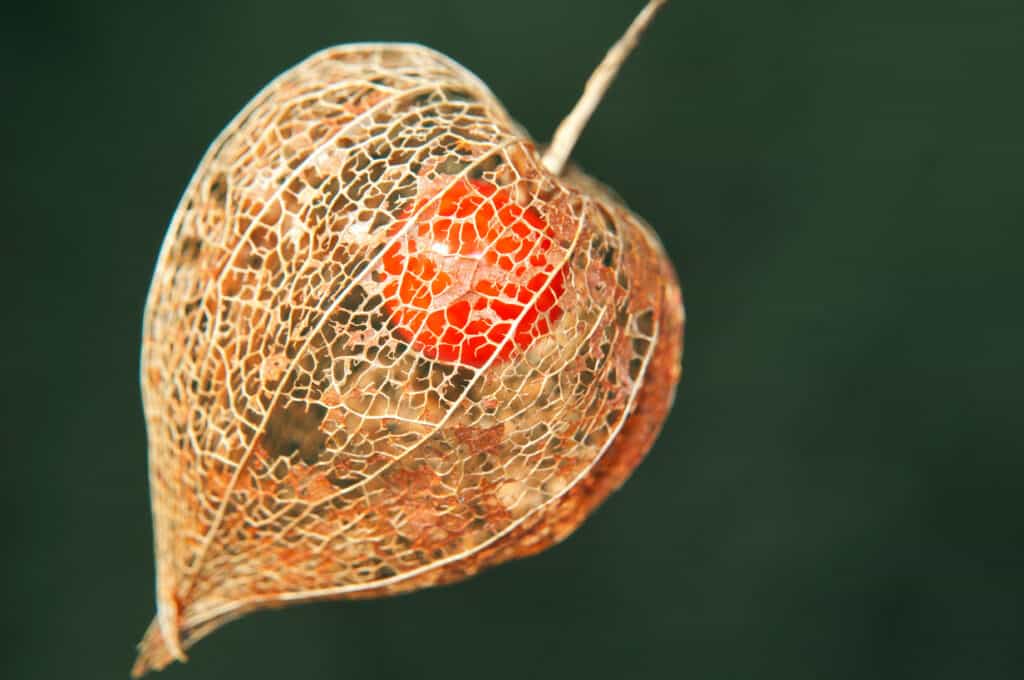When you look at tomatillos and Chinese lantern plants, you are likely to confuse the two unless you look closely. You also aren’t terribly likely to identify either plant as growing “berries” but they technically do. Some folks confuse tomatillos for tomatoes, others confuse Chinese lantern plants for, well, many other things.
Let’s take a look at the similarities and differences between these two unique plants that produce some of the tastiest “berries” around.

A ripe tomatillo on the plant
©Cavan-Images/Shutterstock.com
| Chinese Lantern Plant | Tomatillo | |
|---|---|---|
| Classification | Physalis alkekengi; 80 species in the plant family | Physalis philadelphica; one of 80 species in the plant family |
| Description | Chinese lantern plants grow up to 2 feet in height, with 3-foot spread. They produce white flowers and paper lanterns in bright orange and red. | Tomatillos are edible fruits that grow in off-white or pale yellow paper-like husks on plants that hit 3 feet in height and bear yellow flowers and irregularly toothed leaves. The stems are hairy. |
| Uses | These papery plant pods are used for decorative purposes, in Asian celebrations (lantern festivals), and formerly as herbal medicines. Technically the fruit used to be eaten, but it is less common than other berries and generally is considered poisonous because of adverse effects it has on various people, particularly pregnant women. | Tomatillos are mostly known for their use in salads, salsas, sauces, enchiladas, casseroles, and as pairings with meats and chicken and fish. |
| Origin and growing preferences | Chinese lantern plants grow up to 30 inches in height, with alternating green leaves. They have small yellow-white flowers and produce papery lanterns that earn them their name. Plant them in full sun with evenly moist soil. | Tomatillos come in green or purple varieties most commonly and fill out their husks when they’re ripe. The plants have serrated leaves and yellow flowers. Tomatillos need well-drained soil, someplace to climb, and full sun. |
| Special features and fun facts | Chinese lantern plants have been awarded with some prestigious titles, like the Award of Garden Merit. The plant is also incredibly ancient with fossils dating back to Pleistocene of Germany, and Pliocene of Europe. | Tomatillos go by many names including the authentic “Miltomatl” as found in the Aztec language of Nahuatl. This is name it seems to go by mostly in Oaxaca. |
Key Differences Between Chinese Lantern Plant and Tomatillo
There are some extremely important differences between the Chinese lantern plant and the tomatillo. For one, the lantern plant bears poisonous fruit, while the tomatillo is prized for its flavorful berry used in many recipes. Because of this, it’s important to know the difference so you eat the right plant and don’t become ill.

Chinese lantern plants come with papery husks in red and orange on the same plants.
©Obraz/Shutterstock.com
Chinese Lantern Plant vs. Tomatillo: Classification
The Chinese lantern plant, or Physalis alkekengi, is a perennial herbaceous plant in the Solanaceae family. The plant ranges from Europe and northern Asia naturally, though predominantly it is known for its connection to China. The plant is a part of the nightshade family and the genus name for the plant family comes from the Greek word physa which means a “bladder for the inflated calyx.” The Arabic name for the plant means “bladder cherry,” referencing the fruit in its husk.
The tomatillo, or Physalis philadelphica, is part of the same family Solanaceae. The plant is also known by Mexican ground cherry, Mexican husk tomato, and many other names. The plant is an annual species of the ground cherry, where it gets its nicknames, but it has an edible fruit, unlike the Chinese lantern plant.
Chinese Lantern Plant vs. Tomatillo: Description

Tomatillos come in both purple and green varieties.
©CarlosR/Shutterstock.com
Ground cherries and tomatillos are sometimes confused for each other, as are Chinese lantern plants and tomatillos. The reason is that all three have papery husks that wrap around the fruit inside them. The Chinese lantern plant has the name because of its resemblance to the paper lanterns of the Chinese lantern festivals. The papery husks are bright orange and red, covering the fruit inside. The plants are considered poisonous, all parts of it, including the fruit inside the lantern that looks like a tomato. The leaves of the plant are dark green and heart-shaped and the plants grow up to 2 feet tall with a spread of nearly 3 feet in many cases. One way to tell the difference between tomatillos and lantern plants is that lantern plants have white flowers and tomatillos have yellow flowers.
Tomatillo plants are upright plants that often get as tall as 3 feet in height. The stems are slightly hairy and have irregularly toothed leaves. They produce yellow flowers with axils of leaves and 5 fused petals with dark spots at the bases. The fruits develop inside a papery husk that is yellow or off-white in color, with fruit being either green or purple when fully mature. The fruit will plump and completely fill the husks when ripe.
Chinese Lantern Plant vs. Tomatillo: Uses
Chinese lantern plants are used for many things, including attracting pollinators to your garden. They produce fruit that was once thought edible, as well, and have been used in herbal medicine in past times. The plant should not be used by pregnant women. The plant is now considered poisonous, all parts of it, including the fruit, and should not be consumed. Instead, dry the fruit for display and decoration purposes only. The plant is often used for decorations for fall, as well. Its most prominent use has been in Bon or Obon celebrations in China and Japan, celebrating the time of ancestral return to earth. The reason they are used in this manner is because of the resemblance the lanterns bear to the paper lanterns used in the celebrations.
Tomatillos, on the other hand, are largely used for foods. The tomatillo, when ripe and removed from its papery husk, looks much like a tomato. They are used for salsas, sauces, soups, salads, and much more. They are particularly favored as pairings with meat, casseroles, and enchiladas, as well as simple grilled toppings for chicken and fish.

Tomatillos are often used for salsas and unique sauces.
©Fotema/Shutterstock.com
Chinese Lantern Plant vs. Tomatillo: Origins and Growing Preferences
Chinese lantern plants are perennials that are sometimes considered to be aggressive, invasive weeds in some regions of the world. The plant produces bright orange pods that have been used symbolically in both Japanese and Chinese ceremonies and celebrations for centuries. The pods appear in late summer to early autumn and specifically are used for the celebration of the return of ancestors’ souls to earth during Bon (or Obon) festivals in Japan or Yuan Xiao Festival in China. The inflated seed pods are used because they rather resemble the traditional lanterns used for the ceremony, which are a symbolic gift meant to help guide the souls into unity. The plants are resilient and spread quickly. The berries are not commercially produced and must be obtained from local growers or found in the wild.
Chinese lantern plants grow up to 30 inches in height with alternating medium green leaves that are about 3 inches long. The plants spread out to 3 feet in width, with their small, yellowish white, star-shaped flowers popping out inconspicuously.
You can grow the plant easily from seed or nursery plants, when planted in the spring after frost has passed. They grow best in full sun to partial shade. They need average, evenly moist soil, with full heat of the afternoon.

Chinese lantern plants are often used for seasonal decorations.
©Symonenko Viktoriia/Shutterstock.com
Tomatillos are actually a close relative of the tomato, but they are not the same. Tomatoes pop out as the red round fruit we know so well, while tomatillos come out in husks. The plant has heavily serrated leaves with yellow flowers. The fruit, when it comes, is covered in the paper-thin husk that easily peels away. They look a bit like hanging paper lanterns, which is why they’re often confused with lantern plants. The tomatillos completely fill out the papery husks, though, when they’re ripe. Green tomatillos turn apple-green or yellow when ripe. Purple tomatillos start out green and turn dark purple like an eggplant when they’re ripe.
To grow tomatillos, plant them in pairs during spring after frost dangers have passed. Space the plants 3 feet apart in fertile, well-drained soil, and stake them or plant them near trellis, with full sun.
Chinese Lantern Plant vs. Tomatillo: Special Features and Fun Facts

Even the aged Chinese lantern plants post-season are lovely and often used for decor.
©Stella.Bodamer/Shutterstock.com
Chinese lantern plants have earned the Award of Garden Merit by the United Kingdom Horticultural Society. This unique plant has seed pods that have been found in fossils in the Pleistocene of Germany and sediments dating back to East Anglia, the Miocene of Siberia, and the Pliocene of Europe. It’s also a cousin to the Goji berry plant (which is actually poisonous and otherwise almost identical) and technically, yes, it is related to the tomatillo plant.
Tomatillos have a wide range of names that they’re known by, including Mexican green tomato, tomate verde (which means green tomato), husk tomatoes, jamberries, and Miltomatl, which is its authentic name in Aztec (Nahuatl). Apparently, the word “tomatillo” has only been in print in English since around 1910. Other names, particularly Miltomatl and Mexican green tomato are more likely to be found in older books.
Next Up:
- Are Hydrangea Poisonous to Dogs or Cats?
- Bee Balm Seeds: How to Grow This Pollinator Favorite
- The 14 Best Podcasts About Plants and Gardening
- Lentils vs. Beans: What’s the Difference?
The photo featured at the top of this post is © Symonenko Viktoriia/Shutterstock.com
Sources
- Missouri Botanical Garden, Available here: https://www.missouribotanicalgarden.org/PlantFinder/PlantFinderDetails.aspx?kempercode=b713
- Love to Know - Gardens, Available here: https://garden.lovetoknow.com/perennials/chinese-lantern-plants
- Harvesting History, Available here: https://harvesting-history.com/chinese-lantern/
- Specialty Produce, Available here: https://specialtyproduce.com/produce/Chinese_Lantern_Flowers_17808.php
- Nimvo, Available here: https://nimvo.com/the-chinese-lantern-plant/
- Bonnie Plants, Available here: https://bonnieplants.com/blogs/how-to-grow/growing-tomatillos
- Britannica, Available here: https://www.britannica.com/plant/tomatillo
- Food Print, Available here: https://foodprint.org/real-food/tomatillos/
Thank you for reading! Have some feedback for us? Contact the AZ Animals editorial team.






